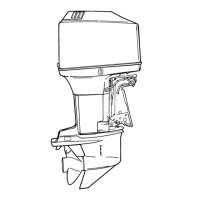90-824052R3 JUNE 2002 IMPORTANT INFORMATION - 1C-3
WATER ABSORPTION
It is imperative that all through hull fasteners be
coated with a quality marine sealer at time of
installation. Water intrusion into the transom core
and/or inner hull will result in additional boat weight
(reduced boat performance), hull decay and
eventual structural failure.
CAVITATION
Cavitation is caused by water vapor bubbles forming
either from a sharp edge or angle on the gear case
or from an irregularity in the propeller blade itself.
These vapor bubbles flow back and collapse when
striking the surface of the propeller blade resulting in
the erosion of the propeller blade surface. If allowed
to continue, eventual blade failure (breakage) will
occur.
VENTILATION
Ventilation occurs when air is drawn from the water’s
surface (excessive trim out angle) or from the engine
exhaust flow (wrong propeller/propeller hardware
installed or gear case labyrinth seal worn) into the
propeller blades. These air bubbles strike the propel-
ler blade surface and cause erosion of the blade sur-
face. If allowed to continue, eventual blade failure
(breakage) will occur.
Engine
DETONATION
Detonation in a 2-cycle engine resembles the
“pinging” heard in an automobile engine. It can be
otherwise described as a tin-like “rattling” or
“plinking” sound.
Detonation is an explosion of an unburned portion of
the fuel/air charge after the spark plug has fired.
Detonation creates severe shock waves in the
engine, and these shock waves often find or create
a weakness: The dome of a piston, cylinder
head/gasket, piston rings or piston ring lands, piston
pin and roller bearings.
A few of the most common causes of detonation in a
marine 2-cycle application are as follows:
a. Over-advanced ignition timing.
(1.)Use of low octane gasoline.
(2.)Propeller pitch too high (engine RPM be-
low recommended maximum range).
(3.)Lean fuel mixture at or near wide-open-
throttle.
(4.)Spark plugs (heat range too hot – incor-
rect reach – cross-firing).
(5.)Inadequate engine cooling (deteriorated
cooling system).
(6.)Combustion chamber/piston deposits
(result in higher compression ratio).
Detonation usually can be prevented if:
1. The engine is correctly set up.
2. Diligent maintenance is applied to combat
the detonation causes.
51115
Damaged Piston Resulting from Detonation

